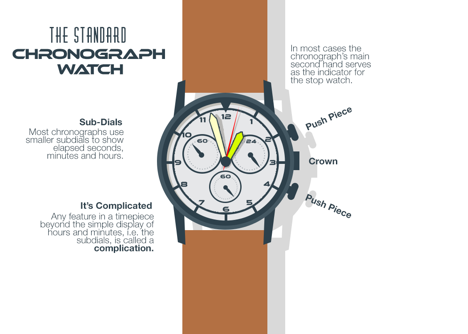The chronograph was invented in 1816 by Louis Moinet for use in tracking astronomical objects.
The term “chronograph” literally means “time writer” and this watch is used for recording time with great accuracy. A chronograph is a watch with a built-in stopwatch feature, which allows it to measure elapsed time. A common feature of chronographs are the smaller subdials, which show elapsed minutes or hours.
It’s Complicated.
Any feature in a timepiece beyond the simple display of hours and minutes, in this case the subdials, is called a complication. A timepiece indicating only hours and minutes is otherwise known as a simple movement. Aside from chronograph functions, other popular examples of watch complications include calendar, perpetual calendar, moonphase, day date, date display.

A Chronograph’s Function
The chronograph was invented in 1816 by Louis Moinet for use in tracking astronomical objects. Chronographs were also used in artillery in the late 1800s. In the early part of the 20th Century, chronograph were sold with fixed bezels marked so they can be used as tachymeters. Over the years, the use of chronographs steadily increased in areas where rapid and precise time calculations are crucial. In the earl days of the US space exploration, chronographs were highly popular as they were first worn by people with the right stuff— astronauts and test pilots. Today, these watches have become indispensable equipment in aviation, car racing, diving and exploration.
Any feature in a timepiece beyond the simple display of hours and minutes, in this case the subdials, is called a complication.
Using Your Chronograph
A chronograph watch will typically have two or three subdials showing hours, minutes and seconds. It will also have a return to zero button, or a pusher on the side of the watch case. In the majority of cases there will be two buttons, also called pushers or push pieces, located above and below the watch crown. The first pusher is pushed once to activate the stop watch. Pushing it again stops the timer. Elapsed time can be read from the second hand, minute hand and the hour hand. The second push piece acts as a reset and returns the hand to the zero position.

In most cases the chronograph’s main second hand serves as the indicator for the stop watch. Most chronographs use smaller subdials to show elapsed minutes and hours.
Today, these watches have become indispensable equipment in aviation, car racing, diving and exploration.
Chronograph vs. Chronometer
These two terms may sound related but there’s a world of difference between them. A chronograph is a type of watch, while a chronometer refers to how well a timepiece performs. A chronograph is an intrument for recording time while a chronometer is a watch that has been tested and proven to be an accurate and superior timekeeper. It is a watch that has passed intense precision tests and has been officially certified by the Contrôle Officiel Suisse des Chronomètres. The COSC is the Official Swiss Chronometer Testing Institute — the body responsible for certifying the accuracy and precision of wristwatches in Switzerland. A watch can be a chronometer with a chronograph function. However, a chronometer does not necessarily mean it’s a chronograph.

